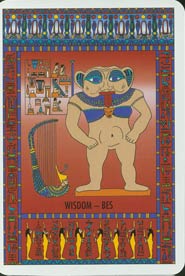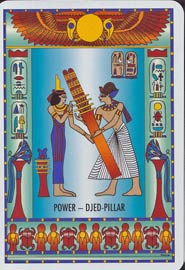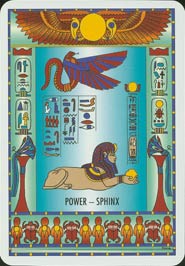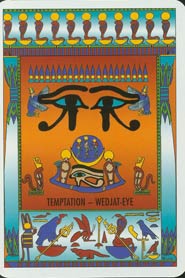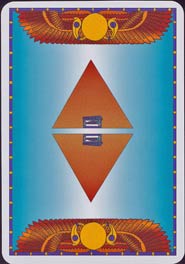Egyptian Pyramid Oracle Deck Review
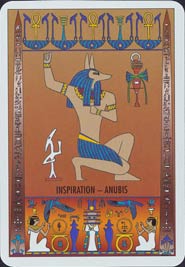
The Egyptian Pyramid Oracle is a set of 25 cards, drawing on Ancient Egyptian mythology for fortune-telling. The deck is divided into five houses of Power, Temptation, Inspiration, Wisdom, and Change with five cards each.
Deck Type: Oracle Deck Cards: 25
Creators: Verona McColl
Publisher: Llewellyn 2003
Retailers
See Price at Amazon.comSee Price at Amazon.co.uk
Egyptian Pyramid Oracle Review by Bonnie Cehovet
The Egyptian Pyramid Oracle is a twenty-five card oracle, broken down into five Houses of five cards each. The accompanying book (soft cover, approximately 3 3/8" by 5", 172 pages) carries an abundant amount of information, in a very well organized fashion. McColl starts out with a general background on divinity, and then moves on to divinity as it was reflected in the every day lives of ancient Egyptians. We look at the importance that symbolism and imagery play in the Egyptian world, how an everyday object was not only seen as something with an express purpose, but was seen as an image representing a deeper concept. It is these ancient Egyptian imagery that McColl has based her deck on.
The Houses are broken down into five categories, reflecting the five elements (1):
1 House of Change:
Overview: Choices are offered and a change is imminent. New beginnings. Symbol: The life-giving Nile. Element: Water Cards:
Water: creativity and mature decisions. Hathor: two faces, two choices Pyramid: youthful power and enlightenment Barque: difficult times, an uneven keel Scarab; self-creation and new life
2 House of Power
Overview: Powerful people are forthcoming. Seek and you shall find. Symbol: The Egyptian Sun Element: Fire Cards:
Sphinx: success and good luck Djed-Pillar: education, spiritual awakening Horus: leadership and authority Bastet: love, harmony and peace Ma'at: balance and justice
3 House of Wisdom
Overview: Self-realization. Spiritual awakening and personal awareness. Symbol: The Egyptian soil. Element: Earth Cards:
Bes: fertility, stability, balance Sekmet: triumph snd accomplishments Thoth: wisdom and learning Osirus: victory over evil Isis: self-confidence and success
4 House of Inspiration
Overview: Courage and understanding. Accomplishments and successes. Symbol: The Egyptian sky, breath of the Ankh Element: Air Cards:
Anubis: strong, protective person Obelsik: overcoming selfish ambition Nut: hope, inspiration and courage Ankh: spiritual awakening and renewed knowledge Papyrus: triumph and fulfillment
5 House of Temptation
Overview: Indecision. The temptation to take the easy way out. Symbol: the afterlife, a fifth element Element: Spirituality Cards:
Wedjat-Eye: a strong and reliable helper Cartouche: a choice is offered Ushabti: conventional thoughts and actions Sebek: good management and outlook Seth: temptation and indecision
McColl also has a small section that offers influences/correspondences between astrology and the Egyptian Pyramid Oracle cards. From the book (2):
* Aries - Scarab (House of Change)
* Taurus - Ushabti (House of Temptation)
* Gemini - Hathor (House of Change)
* Cancer - Sebek (House of Temptation)
* Leo - Bastet (House of Power)
* Virgo - Thoth (House of Wisdom)
* Libra - Ma'at (House of Power)
* Scorpio - Ankh (House of Inspiration)
* Sagittarius - Sekmet (House of Wisdom)
* Capricorn - Seth (House of Temptation)
* Aquarius - Nut (House of Inspiration)
* Pisces - Barque (House of Change)
At the end of the book McColl has a section on dealing the cards and interpreting them, with good definitions for each position. For example, for card/position number three, she states: "This card indicates the fears the seeker has about the question and outcome. It indicates what is inhibiting or standing in the way, or perhaps personal doubts." This section is followed by a glossary of ancient Egyptian terms.
The deck and accompanying book come in a sleeve-style box, with the cards in a flip-style box that opens the long way, making them easy to get in and out. The cards themselves are approximately 3 1/4" by 4 5/8", on quality, glossy card stock. There are three extra cards with the deck: one card carries definitions for the five Houses; one card carries a graphic of the Pyramid Spread, along with position definitions; and one card carries instructions for reading.
The backs of the cards carry a 1/4" white border, with a thin, darker inner border surrounding two golden triangles (one pointing up, the other pointing down) on a light blue background that fades to white around the triangles. At either end of the card, above the triangles, is an Egyptian graphic. It would be impossible to tell whether a card was drawn upright or reversed until the card was turned over.
The card faces are coded by color and graphic type for each of the five Houses. There is a graphic completely across the top of the card, with another graphic going down both sides. A shorter graphic rests between the two side graphics at the bottom of the page. The illustration sits in the middle, with the House name and the card title in black text along the bottom.
From the House of Inspiration, we have the Obelisk. The central imagery is that of a pink granite obelisk, representing the one found at Karnak Temple in Luxor, supposedly the tallest obelisk in Egypt. It was erected by Queen Hatshepsut to worship the God Amun, whom she claimed to be her father. There is no indication what the two animals seated on either side of the obelisk are, and I am not familiar enough with Egyptian imagery to make a guess! In a reading, this card can indicate success through questionable means, that is about to crumble away. (Note: In the book, each card is presented by House, title, description, explanation of the card illustration, upright and reversed meanings in a reading.)
From the House of Wisdom, we have Isis. Isis appears in profile, wearing the solar crown, encased in two cow horns, that is the symbol of Hathor. She also wears a vulture headdress, with outstretched wings, that act as protection. In a reading, this card represents creativity, organization, and ability. Opportunities that are accepted will be successful.
From the House of Power, we have Ma'at. In the center, at the top of a tall stand is an elaborate fan made of bird feathers. From the stand, we see the two feathers of justice balanced against each other. The hieroglyph of the feather represents Ma'at, the goddess of truth and justice. Ma'at figures sit on either side of the feathers, with their winged arms outstretched. In a reading, Ma'at indicates that stability and justice will prevail.
From the house of Change, we have the Scarab. This hieroglyph fascinates me more and more, every time I see it. The Scarab in this illustration is the funerary scarab of Tutankhamun. The solar disk above the scarab pictures the boy-king being accepted into the afterworld by Thoth and Horus. Wild lapwings sit at the base of the scarab, while on either side we see the combined Djed-Pillar, staff, crook and flail of the pharaoh. In a reading, the Scarab indicates joy and contentment coming from achievement and success.
From the House of Temptation, we have Seth. Here we see the Ibis headed figure of Seth in profile. In front of him is Setekh, his companion animal. Seth wears the crown of Atum, and is shown with Apophis, the serpent and opponent of Re, coming from behind him and rising over him. In a reading, Seth indicates the temptations of the devil: bad influences, loss of spirituality, too much attention being paid to the material world. Narrowness of vision is acting as a block to progress.
One thing that did bother me about this deck was the disclaimer on the back of the box that the Egyptian Pyramid Oracle offers a new system of fortune telling that is easier to learn than the Tarot. To begin with, oracles do not have to be used in the "fortune telling" capacity. This belittles their purpose. Moving on from that, there are similar elements in all systems of divination that have to be learned, amongst which are structure and imagery. The learning can be as hard, or as easy, as the student makes it.
Also, some of the definitions for cards that are actually in different houses are disturbingly similar, such as Djed-Pillar: education, spiritual awakening (House of Power) and Ankh: spiritual awakening and renewed knowledge (House of Inspiration). It can be that they are the same essence experienced in different manners through the elements - only working extensively with the cards would show this. From the small amount of spreads that I did (just over a dozen), the oracle does seem to be on target.
I enjoyed working with these cards, and the Egyptian imagery, and feel that they work well on a stand-alone basis, or in combination with other oracles, such as the Tarot, or the Runes.
Footnotes: 1. Ibid pages 5-21. Note: I have not included the description of each house in this excerpt. 2. Ibid pages 24-30. Note: I have not included the description of each sign in this excerpt.
© Bonnie Cehovet
Complete Details of Egyptian Pyramid Oracle
Creators: Verona McCollPublisher: Llewellyn 2003
Deck Type: Oracle Deck
Cards: 25
Deck Tradition: Ancient Egyptian
Card Back: Reversible
Rating: 10/20 or
Similar Decks to Egyptian Pyramid Oracle
Theme: Ancient Egyptian< Previous Deck · Back to Top · Next Deck >
Home > Tarot Reviews > Egyptian Pyramid Oracle Review

